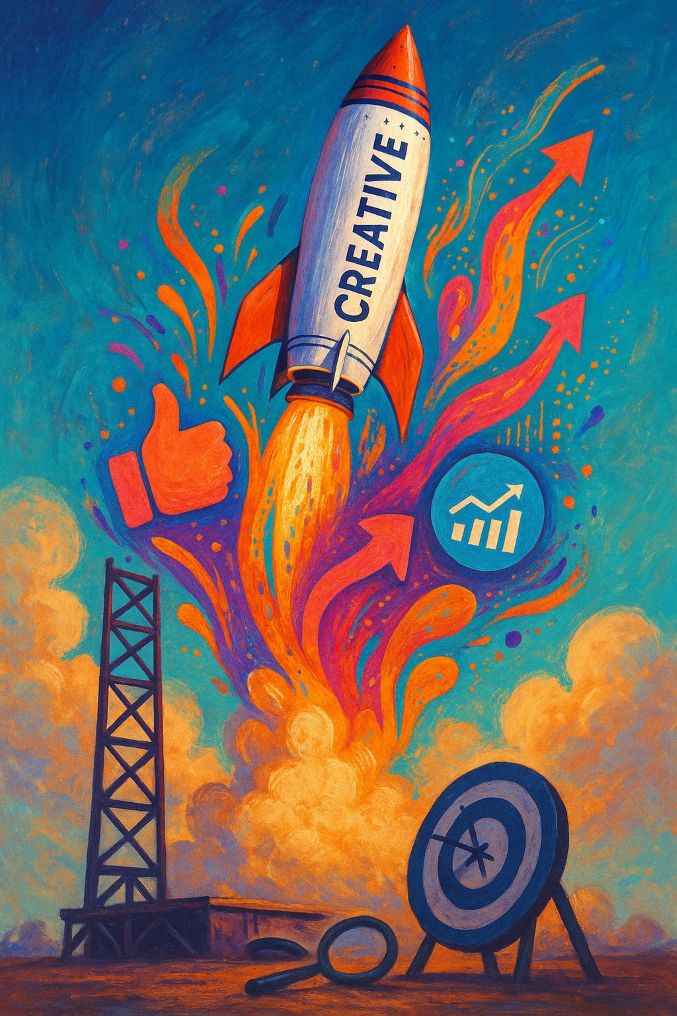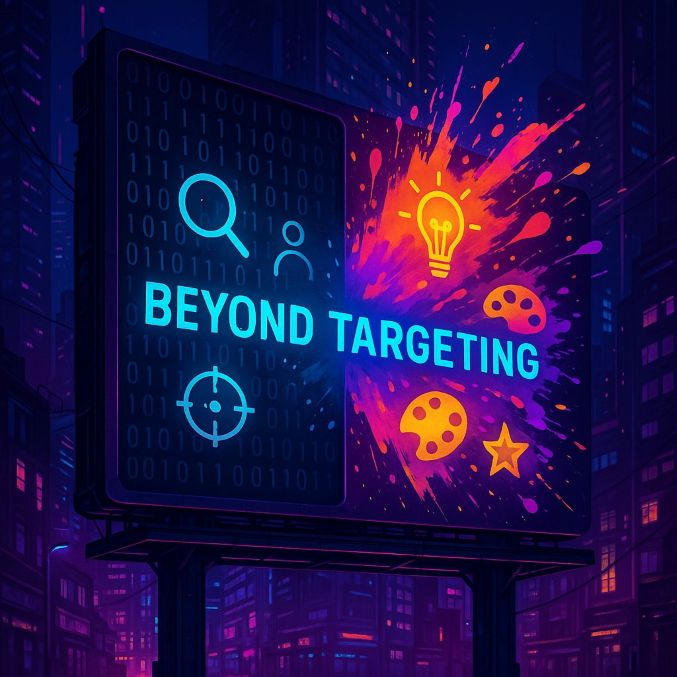Beyond Targeting: How Creative is Becoming the #1 Ad Performance Driver

Introduction: The Fundamental Shift in Advertising's Center of Gravity
The advertising environment has witnessed a paradigm change in proportions of epic scale. While the marketers once depended on surgical targeting of audiences, today we are a time where creative brilliance became the driving force behind campaign success. This has been driven by three interrelated transformations that have dramatically rewritten the book on digital marketing.
First, the fast pace of artificial intelligence on ad platforms has mechanized a lot of what was originally done manually for targeting. Machine learning algorithms have taken over thousands of signals at real-time to calculate best ad delivery, most of the time outperforming human-set targeting parameters. First, the international privacy revolution - evidenced by GDPR, CCPA, Apple's ATT model, and deprecation of third-party cookies - has methodically destroyed the precise targeting infrastructure that marketers assumed as their birthright. Third, the over-saturation of digital ad channels has brought unrivaled competition for consumers' attention, with the average individual now being exposed to somewhere between 6,000 and 10,000 ads per day.
In this new world, creative is now the key differentiator. Nielsen and Facebook research indicates that the quality of creative drives 56% of sales effect from digital advertising, and a Meta study discovered that creative is responsible for 50-70% of ad performance. These statistics highlight a basic truth: with an era of automated targeting and limited data, what you communicate and the manner in which you do it becomes more important than to whom you communicate it.

Why Traditional Targeting is No Longer the Silver Bullet
The fall of traditional targeting methods is among the biggest shake-ups in the history of digital marketing. A number of convergent factors have led to this seismic change:
The AI Revolution in Audience Optimization has drastically altered how advertisements find their way to consumers. Services such as Google Ads and Meta also utilize advanced machine learning models that examine thousands of real-time signals - ranging from engagement to contextual signals - in order to decide the best ad delivery. Google's Performance Max campaigns illustrate this trend, where advertisers input creative assets and business goals, and AI manages audience targeting programmatically. Automation beats manual audience segmentation most times, especially when given high-quality creative inputs.
Privacy Policies have methodically taken down the precision targeting infrastructure. Phasing out third-party cookies, in addition to Apple's App Tracking Transparency framework, has diminished visibility into user activity on websites and apps. Opt-in for iOS app tracking averages a mere 25-30% as of recent reporting by AppsFlyer, greatly curtailing the functionality of retargeting and lookalike audiences. The imminent deprecation of third-party cookies in Chrome (now postponed to 2025) will further drive this trend, pushing marketers to come up with tactics that are less dependent on individual-level targeting.
Attention Economics have redefined the ad value chain. With users being able to scroll away from a piece of advertising in under one second, the creative's power to secure attention has become the decisive gatekeeper to any potential downstream targeting rewards. Lumen Research identified that 9% of online display ads are given over a second of attention, hence disproportionate value was assigned to the first few seconds of creative exposure. Scarcity of attention implies that highly targeted advertisements collapse if the creative cannot hook the viewer instantly.
The Ascendancy of Creative as the Primary Performance Driver
As targeting becomes more automated and restricted, innovative brands are investing more in creative development. This reallocation indicates a fundamental reprioritization of marketing efforts:
Budget Allocation Trends indicate a significant shift in creative spending. In a 2024 World Federation of Advertisers survey, 62% of large brands have boosted their creative production budgets over the last two years and 58% have cut spending on audience data and targeting tools. This shift acknowledges that within platform algorithms, ad distribution is directly determined by creative quality - good-performing creatives get more impressions at lower cost as they have better engagement rates.
The Creative-Performance Link has been empirically validated across industries. An analysis of 1,200 campaigns by Nielsen found that campaigns with above-average creative quality delivered 11x the ROI of those with average creative. Similarly, YouTube's internal data reveals that the top 10% of video ads by creative quality achieve 4x higher watch-through rates and 2x higher conversion rates compared to median performers. These performance differentials dwarf the incremental gains from audience optimization.
Platform Algorithm Updates have consistently emphasized creative quality. Every large platform now employs creative assets as primary ranking signals within ad delivery systems. Facebook's "Ad Quality Ranking" score, for example, considers creative relevance and engagement potential when deciding what ads to display. Google's "Ad Strength" score also measures creative variety and quality as contributors to auction success. These algorithm updates translate to creative quality directly influencing both reach and efficiency in cost.
Anatomy of Successful Creatives in Today's World
To know what makes great creative in the current world is to go beyond conventional advertising dogma. The most effective 2025 creatives have some common denominator traits:
Visual Stopping Power is no longer optional. Neuroscientific evidence shows that the human brain computes images 60,000 times quicker than text, and the initial visual impact is essential. Top-performing creatives use contrast principles (both literal and metaphorical), surprise imagery, and kinetic energy to pierce the scroll. Analysis of top-performing Instagram commercials indicates that those with the use of bold color contrast deliver 38% more engagement, and ads with sudden motion in the initial frame experience 27% more completed views.
Psychological Resonance happens on several levels. The best creatives appeal to deep psychological triggers - curiosity, surprise, recognition, and aspiration - and they engage with cultural moments and consumer identities. An collaborated study by Kantar and TikTok discovered that high-scoring on emotional engagement metrics helped ads to drive purchase intent by 73% in comparison to rational-focused communication. This emotional connection has become particularly crucial as consumers increasingly favor authentic, relatable content over polished corporate messaging.
Platform-Specific Optimization is now a requirement rather than an option. Each major platform has developed distinct consumption patterns and creative norms. YouTube's skippable ad environment demands immediate hooks, TikTok's sound-on culture requires audio-centric creative, and Instagram's aesthetic expectations favor high-production value visuals. Brands who master these native languages to the platforms including LinkedIn witness phenomenal performance - LinkedIn findings indicate that video ads natively created for professional context on the platform have 3x conversion rates compared to re-purposed creative from other media.
The transition from targeting-based to creative-based advertising is more than a mere tactical change - it demands a revolutionary rethinking of strategy and resource allocation. In the section that follows, we'll examine how this shift is being further spurred by new AI solutions that are revolutionizing the way creatives are created, optimized, and scaled.
AI's Role in Amplifying Creative Performance
Artificial intelligence is no longer solely an optimization system for targeting—it is now a key partner in optimizing creative performance. Solutions such as Google Performance Max and Meta Advantage+ increasingly depend on AI to test, adjust, and deliver the best-performing ad variations. These platforms evaluate engagement signals—watch time, click-through rates, and conversions—to identify which creatives most engage audiences.
AI-driven tools also help create and optimize ad creatives in scale. Dynamic creative optimization (DCO) does this by automatically adapting messaging and imagery based on user actions, while generative AI assists in the quick creation of multiple ad variations. Yet, the human factor cannot be replaced—creative strategy, emotional engagement, and brand essence still need a marketer's touch. The optimal outcome is achieved through the blend of AI efficiency with human creativity.
Case Studies: Brands Winning with Creative-First Strategies
A few pioneering brands have already adopted creative-led advertising, with spectacular success.
CRED (India) – With its bold, humorous, and celebrity endorsement campaigns, CRED has perfected the art of thumb-stopping content. Their ads combine humor, high production quality, and cultural relevance, creating a strongly shareable and rememberable experience. By focusing on creative at the expense of narrow targeting, CRED has established strong brand recall in a crowded fintech market.
Chipotle (Global) – The fast-casual brand uses platform-native content, including TikTok challenges and Instagram Reels, to reach younger audiences. Their #GuacDance campaign, which invited user-generated content, spurred a substantial sales lift through the use of entertaining, interactive creative instead of precision targeting.
These cases prove that when brands put money into remarkable creative, they can realize viral reach and prolonged engagement—regardless of wide audience targeting.

How Marketers Should Rethink Their Creative Process
To remain competitive, marketers need to revamp their creative development process. Gone are the days of developing a limited number of finely tuned ads and serving them up forever. Instead, a real-time, data-driven process is necessary:
Test → Analyze → Scale – Deploy multiple creative versions to find top-performing pieces. Employ A/B testing to experiment with different hooks, visuals, and CTAs, and then bet big on what succeeds.
Collaborate Across Teams – Cut silos between marketers, designers, and data analysts. Creative teams must be closely aligned with performance marketers so that artistic expression is matched with conversion objectives.
Iterate Rapidly – Consumer tastes change rapidly. Frequently update creatives to avoid ad fatigue and remain timely.
Platforms now value agility—brands that adjust creatives on the fly using real-time insights get a competitive advantage.
Conclusion: In a Post-Targeting World, Creative is the New King
The advertising playbook has been re-written. With AI and privacy shifts even the playing field in targeting, the fight has moved to creative excellence. Brands that invest in great storytelling, platform-native formats, and data-driven iterative creativity will out-compete those that place their bets on audience segmentation alone.
The future is for marketers who make creative a performance lever, not just a creative afterthought. As businesses adopt this change, they can break through the noise, create richer consumer connections, and generate measurable outcomes in a more crowded digital environment. The message is unmistakable: in 2025 and beyond, creative isn't merely crucial—it's the #1 predictor of ad success.


Comments
No Comments To Display